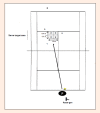Effects of a 6-week junior tennis conditioning program on service velocity
- PMID: 24149801
- PMCID: PMC3761833
Effects of a 6-week junior tennis conditioning program on service velocity
Abstract
This study examined the effects of a 6-week strength-training program on serve velocity in youth tennis players. Thirty competitive healthy and nationally ranked male junior tennis players (13 years of age) were randomly and equally divided into control and training groups. The training group performed 3 sessions (60-70 min) weekly for 6 weeks, comprising core strength, elastic resistance and medicine ball exercises. Both groups (control and training) also performed a supervised stretching routine at the end of each training session, during the 6 week intervention. Service velocity, service accuracy and shoulder internal/external rotation were assessed initially and at the end of the 6-week conditioning program for both, control and training groups. There was a significant improvement in the serve velocity for the training group (p = 0. 0001) after the intervention, whereas in the control group there were no differences between pre and post-tests (p = 0.29). Serve accuracy was not affected in the training group (p = 0.10), nor in the control group (p = 0.15). Shoulder internal/external rotation ROM significantly improved in both groups, training (p = 0.001) and control (p = 0.0001). The present results showed that a short- term training program for young tennis players, using minimum equipment and effort, can result in improved tennis performance (i.e., serve velocity) and a reduction in the risk of a possible overuse injury, reflected by an improvement in shoulder external/internal range of motion. Key PointsA short-term training program for young tennis players, using minimum equipment and effort, can result in improved tennis performance and a reduction in the risk of a possible overuse injury, reflected by an improvement in shoulder external/internal range of motionA combination of core stabilization, elastic resistance exercises, and upper body plyometric exercises (i.e., medicine ball throws), focussing on the primary muscle groups and stabilizers involved in tennis specific movement patterns, could be appropriate for development tennis playersStretching exercises are recommended in the cool-down phase following matches or training sessions.
Keywords: flexibility; performance; service; strength; tennis.
Figures
References
-
- Armstrong N., McManus A.M. (2011) Physiology of elite young male athletes. Medicine and Sport Sciences 56, 1-22 - PubMed
-
- Carter A.B., Kaminski T.W., Douex A.T., Jr., Knight C.A., Richards J.G. (2007) Effects of high volume upper extremity plyometric training on throwing velocity and functional strength ratios of the shoulder rotators in collegiate baseball players. Journal of Strength and Conditioning Research 21, 208-215 - PubMed
-
- Cohen D.B., Mont M.A., Campbell K.R., Vogelstein B.N., Loewy J.W. (1994) Upper extremity physical factors affecting tennis serve velocity. American Journal of Sports Medicine 22, 746-750 - PubMed
-
- Cohen J. (1988) Statistical power analysis for the behavioral-sciences. Perceptual and Motor Skills 67, 1007-1007
LinkOut - more resources
Full Text Sources
Medical

